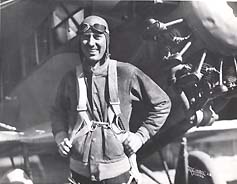On August 15, 1929, Nicholas Bernard “Nick” Mamer (1897-1938), already renowned as a stunt flyer and a military and commercial aviator, and his mechanic and copilot, Art Walker, take off from Spokane’s Felts Field on a history-making feat of endurance flying, a popular form of early aviation competition. In their latest model Buhl “Sesquiplane,” the Spokane Sun-God, they stay aloft five days and nights. Although they do not break the existing record of hours in the air, they set a record in nonstop mileage (more than 7,200 miles) and achieve the first transcontinental refueling flight, first night refueling, and first refueling at an altitude above 8,000 feet. The refueling plan, not always successful, is for in-flight refueling crews to meet them over predetermined locations to lower the fuel hose to the Sun-God in midair. On many airstrips along the transcontinental route, enthusiastic crowds watch them pass or refuel.
News by Dropped Note
This flight, a cooperative venture of the National Air Derby Association, the Buhl Aircraft Company, and Texaco, was coordinated locally by a committee of Spokane’s leading business leaders and aviation enthusiasts. Its main purpose was to break the endurance record of 151 hours aloft set by an Army Air Corps crew flying a tri-motor Fokker, the Question Mark. Major points on the Sun-God’s route from Spokane were Portland, Oakland, Reno, Salt Lake City, Cheyenne, Des Moines, Chicago, Cleveland, and New York, then back to Cleveland, Chicago, St. Paul and west to Spokane. Along this route Nick Mamer not only flew the plane but also provided frequent news dispatches for the Spokesman-Review and other papers. This he did by attaching weights to the notes and dropping them. In addition, in the days before two-way radio, all logistical communication between the plane and the ground had to be by this means.
On the occasions when hose refueling was not available or went wrong, fuel had to be lowered in containers swaying at the end of ropes. This was also the method used for getting food and other supplies to Mamer and Walker. A mishap, which could have been fatal, occurred when rough air caused the Sun-God’s propeller to cut the refueling hose hanging down from the refueling plane. Miraculously, the fuel being sprayed on the top of the Sun-God did not cause an explosion or fire. With tanks dangerously low, they managed to refuel at night with the remaining 20 feet of hose illuminated by a flashlight tied to the end.
A Hero's Difficulties
Ironically, one of Mamer’s most maddening predicaments occurred on August 20 when he arrived over Spokane and circled for six hours to add to the flight time. A magneto malfunction occasioned the exchange of several concerned notes with the Spokane committee on the ground at Felts Field; then an inexperienced refueling crew almost caused a disaster. Mamer dropped the following exasperated note:
“What a fine reception we get! You send that bird up in the Buhl ‘Sesqui’ and he does not realize that I cannot look into the glaring sun and see his ship also. Then after two hours, he finally realizes what is wrong and the man who is lowering the bag is scared and does not know what to do. ... Another mistake they make: when they see you coming for them, they start going like hell, making it all more difficult” (McGoldrick, 156).
This crew finally managed to lower gasoline in tin cans at the end of ropes. The Sun-God completed its feat of flight endurance, staying in the air 120 hours, adding to Nick Mamer’s growing reputation as a hero of early Spokane aviation. President Herbert Hoover sent the following message: “Congratulations on the successful completion of your nonstop refueling flight across the continent and return. It is a further demonstration of the ever-widening scope of the practical utility of aircraft” (McGoldrick, 156).
Nick Mamer continued operating his own flight service in Spokane and eventually became a pilot for Northwest Airlines. In the estimation of Spokane aviation authority James McGoldrick, “Nick Mamer was responsible for more aviation firsts being credited to Spokane than any other person” (McGoldrick, 45).
Nick Mamer was killed on January 10, 1938, in a crash of his Northwest Airlines plane. Art Walker had a distinguished career as a commercial pilot and director of aviation for the Standard Oil Company.

